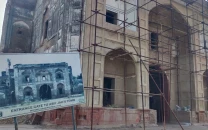SC signals Lahore train to chug
Sets 31 conditions to ensure that no damage is done to heritage sites along the route

PHOTO: PAKISTAN CONSTRUCTION AND QUARRY
A five-judge bench of the top court – headed by Justice Ejaz Afzal Khan and comprising Justice Azmat Saeed Sheikh, Justice Maqbool Baqar, Justice Ijazul Ahsan, and Justice Alam Khan Miankhel – issued a 116-page judgment on the Punjab government’s appeal against the LHC judgment. Interestingly, the ruling was issued eight months after the conclusion of proceedings.
Justice Ahsan authored the main judgment, which endorses and approves the permission letters issued by the authorities and the recommendations of experts relating to the execution, mitigation and remedial measures required to be adopted by the executing agency and allowed the project to proceed – subject to 31 conditions and directions.
Shehbaz blames PTI for delay in Orange Line train completion
The judgment says that a broad-based Special Committee of Experts consisting of the Archeology Department’s director general, a professor of the University of Punjab Department of Archeology, the head of the University of Engineering and Technology, Lahore’s Department of Structural Engineering, a senior professor nominated by the chairman of the board of National College of Arts, and chaired by a retired SC judge shall be notified to oversee implementation of the judgment.
“This committee shall also make further recommendations to the Punjab chief minister to undertake measures as may be necessary to implement and enforce the directions and recommendations made in this judgment. The tenure of the committee shall be one year from the date of its notification,” says the judgment.
The court also ordered the Punjab government to set up a Rs100 million Antiquity and Special Premises Fund which shall be dedicated to monitoring, renovation and reconstruction work of 11 protected and special premises.
“It shall be a revolving fund and shall be replenished on yearly basis. It shall be utilized firstly for the maintenance, preservation, restoration and renovation work of the protected and special premises, subject matter of this list and thereafter on other antiquities and special premises situated in Lahore as may be recommended by the special committee of experts constituted under this judgment.”
If cleared, Orange Line may be delayed by a year
The SC asked the provincial government to retain the services of at least three experts having expertise in the field of archaeology and renovation, preservation and maintenance of antiquities and special premises. “One of the experts shall be a person having expertise in structural engineering. All three experts will work as a technical committee with tenure of one year. The committee shall report to advise and assist the special committee and, if required, with the approval of the archeology director general, it may retain the services of any experts deemed necessary to undertake its work more effectively.”
The ruling emphasises the fact that the present conditions of the protected and special premises calls for major preservation, renovation, reconstruction, and repair work.
“The Government of Punjab shall take immediate steps and we have been assured by the Punjab advocate general that steps shall be taken to start repair and renovation work for which the requisite funds will be made available within thirty days from the date of this judgment,” says the judgment, while ordering the Punjab government to initiate the steps within 30 days.
Justice Ahsan said, “All over the world, where heritage sites are located within cities, the development of the cities is planned in a manner so as to maintain a balance between infrastructural development while retaining/preserving and maintaining the heritage sites. This is often a difficult balance to maintain, but a number of cities all over the world have successfully managed to do so. London, Rome, Istanbul, Beijing, Delhi, and Jaipur are but a few examples.
Delay in Orange Line project ‘to result in huge losses’
“We have no reason to believe that this cannot be done in Lahore. There can be no two views about the importance of our historical and heritage sites and the need to preserve and protect them and to safely pass them on to the future generations. But the same need not be at the cost of depriving the citizens of Lahore of an efficient, reliable, dependable and modern mass transit system and to force them to live with an outdated, overstrained, inefficient and expensive system which in addition to all its faults is badly polluting the city pushing air pollution to levels, many times the safe and internationally acceptable limits. Preservation and development are not mutually exclusive and can go side by side complementing each other as has successfully been accomplished in many cities of the world. All it requires is proper planning and efficient implementation.”
The court also raised serious questions over the LHC’s verdict for halting the project, saying, “We are at a loss to understand how reports by credible professionals could be discarded and so easily, without an in-depth comparative analysis with independent technical reports to be submitted by the respondents, which were never submitted.
“Simply on the allegation that Nespak, Dr Uppal, and Dr Rogers had undertaken projects for the respondents in the past and were therefore partial and biased, the High Court not only discarded the reports casting unjustified doubts about the independence and integrity of the experts but also proceeded to throw out conditional permission letters issued by authorities competent under the law to do so after due deliberation and application of mind to all relevant material.
LHC suspends work on Orange Line train project
“We are unable to understand why and how the high court could discard the opinions of experts and persons mandated by law to make decisions based on such opinions, arrogate such powers to itself and proceed to substitute unchallenged and unrebutted technical opinions of experts with those of its own despite complete lack of training and expertise in the fields of structural engineering and vibration sciences.
“In our opinion, the High Court erred in law and quite obviously exceeded its jurisdiction in doing so, without assigning valid, cogent, sound and legally sustainable reasons. We are, therefore, unfortunately, unable to agree with or uphold the findings of the learned High Court in.”
Justice Ahsan noted that ancient buildings suffer damage and decay on account of the passage of time, elements of nature, extremities of weather, environmental factors, seismic activity and earthquakes, etc. “These cannot be preserved indefinitely unless serious and planned effort is made to constantly repair, maintain, renovate, restore and reconstruct the damaged portions. It is indeed unfortunate that very little serious effort has so far been made to implement and enforce measures to protect, preserve, repair and restore such sites. The matter came to fore and was highlighted once construction work on the OLMT Project commenced.
“We are constrained to observe that serious efforts need to be made by the concerned departments and agencies to preserve, conserve, restore and protect heritage sites and, where necessary, renovate, not only the sites which are the subject matter of these proceedings but all other sites of historic significance on a continual basis. This can be done by employing experts in their respective fields and allocating the requisite funds generously to finance such projects on a long-term basis. In this regard, we would issue appropriate directions to the concerned authorities in the latter part of this judgment.”
LHC stops metro train construction near 11 historic sites
31 conditions
The SC directed the Punjab government to make all necessary arrangements to ensure that the monuments remain stable and undamaged in all respects during the execution of the project as specified in the HIA and Study of Control of Vibration, Noise and Foundation.
The order says, “Vibration monitoring shall be undertaken as a part of the monitoring plan using the crack measure devices such as Avongard Standard Tell-Tale throughout the construction period and for an additional period of 10 weeks from the date of commencement of commercial operation of the train or such further time as may be directed by the archaeology director general.
“In case, it is found that vibration levels at any stage of the construction or operation are exceeding safe limits, construction work shall immediately be discontinued and remedial action shall be taken to ensure that such levels are brought down to acceptable limits. Such actions may inter alia include use of one piece of equipment at a time, during the construction phase, adjustment of train speed, addition of buffers and such other remedial and mitigating measures as may be recommended by the experts.”
The order adds, “Technical experts shall be present at the sites during the construction phase in the vicinity of the antiquities and special premises with all necessary equipment for monitoring vibration levels; and in case, vibration levels exceed the acceptable limits, work shall immediately be stopped, remedial measures are taken to the satisfaction of experts, and further work shall not commence unless written clearance for the resumption of work is given by the experts.
“An independent and experienced conservation engineer shall be appointed to monitor the project, both during the construction and operation phases. He shall submit monthly reports to the advisory committee which shall make such further recommendations to the archaeology director general as may be required to ensure that the project as a whole is meeting all technical requirements meant to preserve, protect and conserve the antiquities or protected premises.
“On completion of the project, the train shall be operated on an experimental basis for at least 2 weeks on the entire length of the route and the vibration levels shall be monitored to ensure that the same is within the acceptable limits. Commercial operation shall not commence unless written clearance is given by the experts confirming that vibration levels have consistently been found to be within acceptable limits.
“The speed of the train shall be reduced while passing near the monuments as recommended by the directorate general, archaeology from time to time on the basis of data made available to it and the state of the art vibration measuring equipment shall permanently be installed at suitable places in and around the antiquities and special premises to monitor levels of vibration created by operation of the train.”
The ruling says that special teams consisting of qualified experts would be set up to periodically inspect all antiquities and special premises to detect any damage or deterioration at the sites.
PTI to rally opposition against metro project
The court also rules that any damage or deterioration shall be reported to the archaeology director general in writing who shall take remedial steps necessary to ensure the safety of the buildings and structures.
“Recommendations of the advisory [committee] shall be placed before the directorate general of archaeology, who shall take necessary steps to ensure that the same is complied with in letter and spirit by all concerned agencies, contractors, sub-contractors and operators, [and] where excavation is necessary it shall be carried out in a way that it would not affect any structure or foundation of the antiquities or special premises. Necessary special arrangements shall be made to stabilize and strengthen the structure of the antiquities and special premises. All necessary safety arrangements shall be made in accordance with the best engineering expertise during excavation, construction and execution phases of the project.”
The court says that executing agency shall be responsible for installing accelerometers, velocity transducers, noise detectors and vibration measuring equipment near the antiquities and special premises. The appellant shall have to ensure implementation of additional mitigation and remedial measures as mentioned in vibration analysis report by NESPAK, Heritage Impact Assessment (HIA) as well as in the reports submitted by Dr Uppal and Dr Rogers.
The court says, “A dedicated hotline shall be set up, and telephone numbers shall be prominently displayed in public areas around all antiquities and special premises for reporting damage or deterioration observed by members of the public or tourists.
“Dust pollution during construction shall be controlled through extensive sprinkling, while the design of the viaduct and nearby stations in terms of colour and designing shall be in harmony with the setting and appearance of the monuments.”
Apex court questions LHC’s Orange Line verdict
Past Panama
An interesting aspect of the case was that three judges who disqualified former PM Nawaz Sharif in the Panama Papers case issued judgments in favour of the PML-N-led Punjab government.
Justice Ejaz Afzal Khan, Justice Azmat Saeed Sheikh and Justice Ijaz-ul Ahsan were all on the Panama bench.
Justice Ahsan said, “All over the world, where heritage sites are located within cities, the development of the cities is planned in a manner so as to maintain a balance between infrastructural development while retaining/preserving and maintaining the heritage sites.”



















COMMENTS
Comments are moderated and generally will be posted if they are on-topic and not abusive.
For more information, please see our Comments FAQ